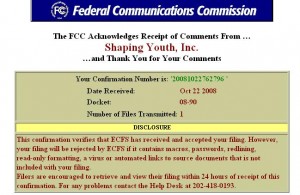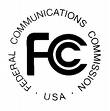 That’s my official FCC filing at left, (squeaked in under the deadline today, explained why later) which emphatically states kids should be OFF LIMITS to embedded ads designed to bypass the Tivo tactics of wise wee ones who blip through traditional commercials to get back to their favorite show unscathed.
That’s my official FCC filing at left, (squeaked in under the deadline today, explained why later) which emphatically states kids should be OFF LIMITS to embedded ads designed to bypass the Tivo tactics of wise wee ones who blip through traditional commercials to get back to their favorite show unscathed.
I’ve written about this a lot before, vetting thoughts about free speech vs. commercialism and I still maintain one can be ANTI-censorship, and also ANTI-product placement…
This is NOT oxymoronic in kids’ programming by any means. Disclosure. Transparency. Clear lines. Not so hard to digest, is it? In this election year of sounding off, what better way to have your voice heard than sounding off to the FCC about our industry’s use of product placement in kids’ programming…
What IS product placement vs. product integration?
How has it begun to reshape the economics of broadcast television?
When did the boundaries between advertising and programming get so blurred and obnoxious that we see paid cups placed with McDonalds café roast rollout in front of news team anchors?
Moreover, how do we advocate for the “under 8s” who can’t discern the difference between advertising and programming per this Kaiser Family Foundation study, along with multiple reports showing kids’ psychological vulnerability to brandwashing?
 Broadcast media is the FCC topic, but one peekat AdVerLab shows we’re already seeing paid product placement creep into children’s fiction books, far beyond Cathy’s Book that caused such a stir awhile back…and as cool as the ‘civic experiment’ of creating a musical road is by altering the pavement to play a song (I’m not kidding, check out the video on AdVerLab; a great site for keeping up on stuff) you KNOW the Honda funding factor gives me the ‘hmmnnn…’ because if you can play music with road grooves, you can play ads. I sure as heck don’t want to be driving down the highway having product placement coming at me through my tires, ya know?
Broadcast media is the FCC topic, but one peekat AdVerLab shows we’re already seeing paid product placement creep into children’s fiction books, far beyond Cathy’s Book that caused such a stir awhile back…and as cool as the ‘civic experiment’ of creating a musical road is by altering the pavement to play a song (I’m not kidding, check out the video on AdVerLab; a great site for keeping up on stuff) you KNOW the Honda funding factor gives me the ‘hmmnnn…’ because if you can play music with road grooves, you can play ads. I sure as heck don’t want to be driving down the highway having product placement coming at me through my tires, ya know?
So there’s a much bigger question here than FCC’s broadcast policy as it pertains to the hard sell to kids (and adults!) via product placement universally. Still, the topic on the table for now is limited to FCC boundaries and kids:
What constitutes ‘kids programming?’ What age bracket is the FCC supposedly ‘safeguarding?’ How is the seepage of prime time product placement ubiquitously trickling down to reach ever-younger kids?
Where does the FCC stand? Where do you stand?
“Pay for prop” style product placement is common on American Idol, ($26 million PER product integration, meaning, each Coke, AT&T, etc. gig, per Ad Age; which is a HUGE chunka change, especially when there were 4151 product placements in the first 38 episodes of the year; 14 minutes per show on average!)
But are KIDS aware? Meh, not really…
Not even remotely in the single digits unless there’s a media savvy parent deconstructing in play by play mode…The younger the audience skews (it IS a primetime family show, not aimed specifically at kids) the more the demographic overlap and wee one appeal starts to open up the FCC Pandora’s Box…
Which poses the obvious query: What DOES constitute ‘kids programming?’ Look at the metrics and Nielsen ratings, they sure as heck know who’s watching what…and the FCC needs to be reminded of the ‘primetime’ concept of family-friendly programming…
I dare you to play hide and seek with kids for media literacy, you’ll find fun items like:
Subtle camera pans like an establishing shot that zooms in on a brand logo…
Characters and leads roles that spew out product names…
An actor that covets a certain item…
Or a soap ‘sponsored by’ xyz corporation with universal product placement in retro style. (Somehow that seemed easier as we all KNEW who was paying for what in ‘brought to you by’ mode…)
Then there’s random product immersion and “content integration” that blends a brand smack dab into the vapid plotlines.
Frankly, that last one makes writers like me cringe. I guarantee somewhere there’s a WGA scriptwriter mumbling to themselves with head in hands, feeling the harsh sting of a sellout…I can just hear the creative revs and edits briefing,
“Could ya get the Oreos into a hero shot, hon?’ argh.
 I’m not even bothering to include NEW forms of product placement that tweens and teens are seeing on cable networks like the CW, because under 12s shouldn’t even BE on the CW network to begin with……
I’m not even bothering to include NEW forms of product placement that tweens and teens are seeing on cable networks like the CW, because under 12s shouldn’t even BE on the CW network to begin with……
Especially with trashy behavioral cues and masterful marketing embedding teen soaps like Gossip Girls into the adolescent mix. (their racy ad campaign was just the tip of the iceberg)
CW is highly adept at product placement via ‘content wraps’ and ‘webisodes’ basically a group of product integrated commercials with a serialized story interspersed throughout a show)
AND the CW 5-second bursts of advertising content they call “cwikies” set inside the show are worth a mention, because it will no doubt influence where the economic model is going into Media 3.0 if the FCC doesn’t clearly define some rules.
As an unbeholden industry veteran, I feel I need to voice a strong ‘knock it off’ as it’s clearly a direction that’s obnoxiously taking hold to the point of altering the creative landscape. It will o doubt impact the quality of programming universally.
I’m not even addressing product placement in adult shows like the Sex in the City bonanza which made Jimmy Choo and Manolo Blahnik shoes household words, or today’s Desperate Housewives integrating teen social media plotlines, name-dropping or hawking cars and goods ad infinitum.
We’re talking KIDS ONLY for now…
And the hybrid ‘line-crossing’ of product placement when big pharm used Happy Feet penguins to sell flu meds to ADULTS (via kids!) Remember my post on that one? Bold. First of its kind maneuver using kids to sell parents via tap dancing cuties.
Overall, I can honestly say my FCC commentary was business-like and restrained, staying on point and in alignment with the consortium in support of the formal CCFC filing, (25pp pdf here) but in my summation I got a bit…um, “direct” and didn’t mince words.
The whole reason I delayed so long in filing with the FCC was I was hoping to pull together a vast, comprehensive list of industry folks who authentically share this concern and were willing to speak out on same…
Fat chance. Quell surprise, lots of talk, little action due to anonymity concerns.
Though I truly understand the job security issue for my colleagues, (with no salary here just yet I don’t have a lot to lose!) I admit it provoked me to strengthen my stance in the filing summation to add the views of MANY industry parents who can’t/won’t add their voice for economic stability reasons…
So my ending sign-off was a tad harsh…
“The pervasiveness of product placement is akin to corporate pedophilia at this juncture as business interests are literally stalking, profiling, and harassing young children. It needs to stop. It must stop. As we say at Shaping Youth, the price we pay to mine their childhood will ultimately cost us all.”
Mea culpa if I embarrassed anyone, but this is a hot button, because as much as I champion media literacy, I’ve found it to be only moderately effective among the very young where brands have undue influence and amazingly powerful pull. (and I include Elmo, Dora et al in that mix!)
Example: In our Dare to Compare: Gross Out Game for Good Nutrition we ask kids to track their intake of media, munchies, and meals…guess what? Definite corollary.
Even AFTER a heavy-handed dose of media literacy where Shaping Youth sends kids on ‘scavenger hunt’ homework assignments to identify title/naming rights, placement and branding, product placement (pay to prop) storyline integration, and ambient ads…Kids invariably STILL don’t ‘catch’ some of the very obvious examples right under their noses.
At school, in the classroom, or even in the final ‘pen test’ where I give them Shaping Youth freebies to take home as a query of brand awareness to see if they ‘catch’ our logo as a ‘brand,’ …some do, some don’t.
Again, education alone is not the answer with younger kids. (Kids shown here are 5th grade tweens) Policy and practice needs to come into play.
The FCC supposedly has “longstanding policies” to protect children from “confusion that may result from the intermixture of program and commercial material” with bumpers between programming and commercials to help children distinguish between the two, but let’s face it, the Children’s Television Act (1990) is in dire need of an overhaul, since many shows themselves have become program-length commercials!
How did we get into this marketing to kids mess, back when childrens’ deregulation of advertising hit the fan?
When did content devolve to simply becoming a merchandising opportunity?
What are the arguments pro and con from industry, parents, free speech advocates, and the FTC?
Once upon a time we had Sesame Street and Mr. Rogers Neighborhood “enhancing attentiveness and perceptual abilities,” with life lessons and meaningful content…Now we have Spongebob squealing in that annoying high pitched cartoon screech hawking his own brand online and off…which begs the question, when is entertainment a commercial in itself?
Mind you, due to obesity issues and parental outcry of foul play, Nickelodeon has wisely used Spongebob’s ‘Bikini Bottom’ brigade to hawk produce recently…But the brand still shows up on a plethora of junk food, so it still smells fishy under the sea if spinmeisters are positioning this in a ‘new and improved BFY’ (better for you) nutrition ploy.
Marketing Research agency Just Kid Inc. has published a summary of BFY ‘marketing don’ts…it’s a snapshot of how these BFY foods will flail or flourish…see if you agree.
As for ol’ Mr. Squarepants, until Spongebob handlers ditch the pitch for junk food altogether I say it smacks of industry bait-n-switch PR tactics that only ADD to Spongebob saturation…
AND…Until the FCC propensity to turn a blind eye toward rampant product placement and consumption in kids’ programming corrects itself, it seems there’s more than enough ancillary spillover to sound the “unfair to parents” bell. Ding-ding! (I’m SO weary of industry forces lobbing that lame, “where are the parents?” hackneyed phrase, when they’re making it harder everyday to combat the assault to win the ‘hearts and minds’ of tiny tykes early on)
What is the age litmus to determine who can discern ‘product placement? How young is young?
If the FCC is going to allow advertisers to embed broadcast programming with seamless product placement, shouldn’t media literacy be mandated in schools? It’s high time we look at that ANYway, given our changing culture. And if it can’t help mitigate regulation via ‘pop up’ disclosure, that’s a winner.
Call me artsy, but I sure as heck don’t want annoying disclaimers or icons breaking the content flow to flag some paid prop in a scene…I’d prefer to ‘stay in the moment’ if I’m going to engage with the medium at all.
Aside from the FCC broadcast sphere, what about the rising infiltration of rampant commercialism in digital media? It’s at risk of cluttering up ‘virtual playgrounds,’ and altering the new media conversation altogether…What could be an educational, interactive, engaging form of learning and play has primarily become an ‘engaging form’ of branding at ever younger ages…
How can we take back the internet so kids aren’t playing tag in consumption-driven dodgeball?
Just as we’ve seen with junk food marketing and advergaming, (a quick peek at DigitalAds.org will seer the extensiveness of this into your psyche) the social media, tween and younger virtual worlds are being served up branded content and product placement deep, DEEP within online gaming. Marketers have entered a mode of ‘let’s play where they play’ kid-stalking for marcom.
That doesn’t sit too well with me, as I’m not wild about big guys pickin’ on little kids.
Just leave ‘em alone, I say!
Yah, yah, I know, ‘gotta fund it somehow’ and “if you don’t like it then don’t watch, or don’t go online, or don’t use the media, etc.”—Sorry, folks, but that seems extreme to me.
Why can’t we ask industry for accountability and responsibility in ‘playing fair’ and not targeting young kids who can’t discern branded product placement…is that so hard?
I LOVE multiple forms of media and communications, as do kids…Why should we be banished from the opportunity to use the technology in fun, safe, empowering ways just because corporate coffers can’t self-rein with some common sense and hands-off rules?
Sheesh. It’s not hard to find a win-win compromise here, folks.
Children have a right to grow up without commercialization in every aspect of their lives. Peer to peer influence works, yes, we get that…Brand engagement where kids interact in fun entertaining ways ‘sticks’ in their recall…we get that.
But where are those lines in the sand? Where is the concept of violation of trust?
Do we really want it to become a world where kids can’t even play with a friend without wondering whether the pal is part of a ‘street team’ as a product ‘influencer’ shilling for some corporate gizmo for hire?
Where does the line of product placement start and stop?
Ideas? Thoughts? Anonymous comments? Feedback, please?
Visual Credits: Hard Sell to Kids Logo, CBS News ‘Gotta Have It’ series, American Idol photo/Ray Mickshaw/FOX
Honda’s “Civic” project: Musical Road Plays William Tell Overture.
(How ’bout “The Long and Winding Road? 








And speaking of product placement, check out Sara Grimes post on Disney/Club Penguin’s foray into product tie-ins in her Gamine Expedition blog! (see sidebar)
Will recap in a post soon, but meanwhile, here’s her blurb:
“Club Penguin celebrates its third anniversary with the launch of new toy line of internet-connected products, including plush, mini-figures and play sets. A new limited edition plush figure will be released every eight weeks, each of which comes with a coin featuring a code that kids can use to redeem unique virtual items online. The Club Penguin toys will be available at Toys “R” Us…Disney Stores, Disney Theme Parks, and the Club Penguin shop online. Additionally, Disney will release the new Club Penguin: Elite Penguin Force game for Nintendo DS next month”—(and more…)
Look out Webkinz! Here comes the Disney promomachine!
Read more about the Club Penguin DS game here. Also, be sure to check out this Club Penguin toyline/So You Think You Can Dance Canada? cross-over promo event and photo opp planned for this Saturday at the Toys “R” Us Vaughan Mills, Ontario. It looks like Disney is finally ready to start cashing in on their $700 million investment. And it looks like I’m going to have to get serious about plotting how this new emphasis on tie-in products might translate into new features, changes, and/or embedded marketing in the game’s contents and design.”
Here’s her full post:
http://gamineexpedition.blogspot.com/2008/10/club-penguin-gets-all-dolled-up.html#links
Saw your post made it on the Ypulse newsletter today…Anastasia says it’s “Definitely worth a read.” Congrats, Amy!!
.-= Melanie M. Lazarus, MPH´s last blog ..Playnormous VP Publishes Health Game Book =-.
As always, you know these things before I do… This FCC stuff is ‘old news’ so perhaps she’s looking at the follow up we’ll be doing on digital privacy and COPPA compliance with Jeff Chester from the CDD soon…???? I dunno…either way, it’s important work for all to consider.
This FCC stuff is ‘old news’ so perhaps she’s looking at the follow up we’ll be doing on digital privacy and COPPA compliance with Jeff Chester from the CDD soon…???? I dunno…either way, it’s important work for all to consider.
I just noticed the Ypulse links via Variety & Bloomburg, but I must say, I like Anastasia’s very first take on this for Business Week where she cited the need for an overhaul of the Children’s Television Act…
http://www.businessweek.com/technology/content/feb2008/tc20080227_269559.htm
I’d responded on the BW blog (albeit with weird coding glitches) as follows:
“As the founder of the new nonprofit Shaping Youth dealing w/media & marketing’s impact on kids, I’m eager to work with thought leaders like Anastasia to build bridges rather than barriers, because I truly believe content is both the problem and solution.
Why not challenge industry to yield the promise and potential of digital media for healthier behavioral cues/product choices beyond coinage & consumption? We’ve been using industry tactics to create fun, counter-marketing appeal in “lift and reveal” media literacy mode, (akin to the successful ‘truth’ campaign/teen anti-smoking blitz) leveraging media as a distribution channel.
The ultimate mindshift transpires when youth are immune to the toxic cues, and advertisers resist putting them out there to begin with.”
I still stand by that mindset…and am eager to ‘broker a middle ground’ with others aspiring to create ‘good’ in the digital and broadcast media sphere…
.-= Amy Jussel´s last blog ..Food Inc. Review: Will Kids Be Hungry For Change? =-.